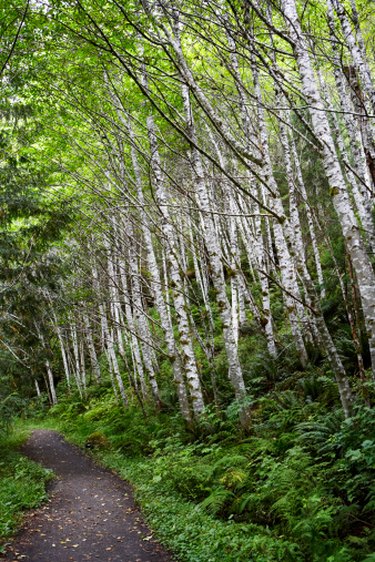Things You'll Need
Pruning saw
Pruning shears
Sharp knife
10-10-10 fertilizer
Mulch

Birch bark, wood, and branches are notoriously susceptible to injury, because their bark is naturally thin and papery and their wood is naturally soft. Birch trees wounded by storm winds, snow, ice or hail may be in big trouble. Once a wound occurs, there are a few things you can do immediately to help it heal. Long-term improvement of cultural practices will also help it recover, and prevent diseases and insects from further weakening the tree.
Step 1
Assess the wounds on the birch tree to determine whether it's worth saving, A tree split down the middle won't survive, nor will a birch tree with a trunk with bark that is cut all the way around. On the other hand, a split crotch, broken branches and some types of holes can be repaired.
Video of the Day
Step 2
Remove broken branches at the trunk of the birch. For branches less than 2-and-1/2 inches in diameter, use pruning shears. Angle the shear blades at 45 degrees, cutting down and away from the trunk. Leaving a short, angled stub will allow moisture to drain off and the tree will heal faster.
Step 3
Remove broken limbs larger than 2-and-1/2 inches in diameter with a pruning saw, using the three-cut method. Make the first cut 12 inches from the trunk, halfway through the branch, starting at the underside. Make the second cut an inch away, halfway through from the top side. The branch will snap of its own weight as you cut. Make the third cut all the way through the branch at the trunk, as in Step 2.
Step 4
Trim torn bark and the edges of holes with a sharp knife. Angle the knife sharply in a shaving motion, leaving torn edges smooth.
Step 5
Help the tree heal by strengthening its environment. Fertilize once a year in early spring with a 10-10-10 fertilizer, following the directions on the package for the size and age of the tree. Spread a 3-foot ring of mulch, 2 to 4 inches deep, starting 6 inches from the trunk to suppress weeds, regulate soil temperature and hold moisture in the soil.
Step 6
Water the wounded birch to keep soil moist at least 6 inches below the ground line, but not enough to make the soil soggy. Watering helps the tree support new growth, utilize fertilizer and helps the tree resist diseases that infect weakened trees.
Tip
Delay heavy pruning for shape for at least a year if the birch. While you must remove broken and split branches immediately, pruning more than a third of healthy foliage in any given year will seriously weaken a wounded tree.
Warning
Do not apply putties or paints to birch tree wounds. Where these practices were once common, they are no longer recommended by any reputable source, other than the companies that make the products.
Video of the Day